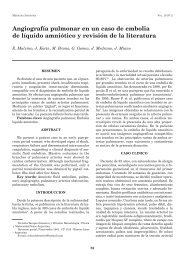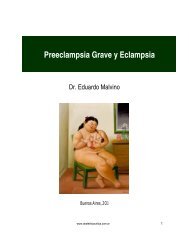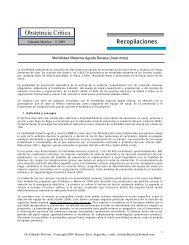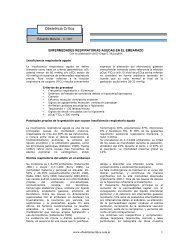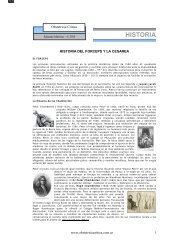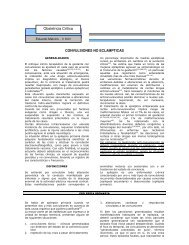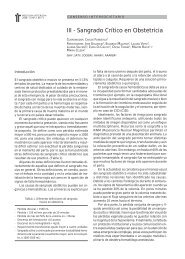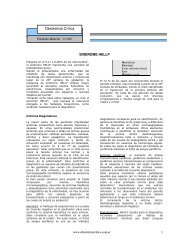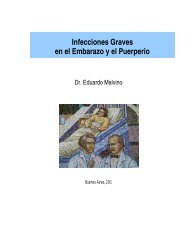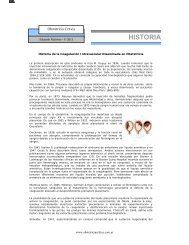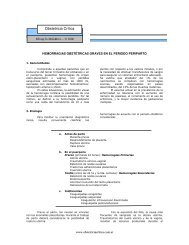prophylaxis for RT-positive women and their infants. RESULTS: Overall, 89.2%of eligible women (3671/4117) underwent RT, of whom 90.4% received resultsbefore delivery. HIV seroprevalence among all women who underwent RT was2.7% (100/3671 women); among previously untested women, seroprevalencewas 6.5% (90/1375 women); the incidence of HIV seroconversion among womenwith previous negative tests during pregnancy was 0.4% (10/2296 women). Afteradjustment, the main predictor of receiving RT results after delivery was lateadmission. Among HIV-exposed infants, 97.9% (92/94) received prophylaxis;61.7% (58/94) had available follow-up data, and 8.6% (5/58) met criteria fordefinitive or presumptive HIV infection. CONCLUSION: The RT programachieved timely detection of HIV-infected women in labor with unknown HIVstatus and effectively prevented perinatal HIV transmission.Am J Obstet Gynecol. <strong>2008</strong> Feb;198(2):173.e1-5.Maternal-Fetal Medicine Units Network cesarean registry: impact of shiftchange on cesarean complications.Bailit JL, Landon MB, Lai Y, Rouse DJ, Spong CY, Varner MW, Moawad AH,Simhan HN, Harper M, Wapner RJ, Sorokin Y, Miodovnik M, O'Sullivan MJ, SibaiBM, Langer O;National Institute of Child Health and Human Development Maternal-FetalMedicine Units Network. Department of Obstetrics and Gynecology, CaseWestern Reserve University, Cleveland, OH, USA.OBJECTIVE: This study was undertaken to evaluate the effect of change of shiftfor physicians and nurses on complications associated with cesarean delivery.STUDY DESIGN: 17,996 term women undergoing an unscheduled cesareandelivery in 13 centers from 1999-2000 were included. Maternal and neonatalmorbidities were evaluated by time of infant delivery vis-à-vis nursing change ofshift (6 AM-8 AM, 2 PM-4 PM, 10 PM-12 AM vs all other hours). The sample wasthen limited to weekdays only and physician shift changes were evaluated(physician shift change 6 AM-8 AM, 5 PM-7 PM vs all others). A composite of 30maternal morbidities was also evaluated by logistic regression, controlling forpotentially confounding factors. RESULTS: Physician change of shift had nomeasurable effect on maternal and neonatal outcomes. Neonatal facial nervepalsies were increased at nursing change of shift (5 vs 0) as werehysterectomies (33 [0.24%] vs 23 [0.53%]; P < .007). Nursing change of shift hadno impact on composite maternal morbidity after controlling for age, race,insurance, medical problems, prior incision type, weekend day, and prenatal care(odds ratio = 0.98; 95% confidence interval = 0.89-1.08). CONCLUSION:Physician change of shift does not appear to be associated with an increase inmorbidities. However, cesarean delivery during nursing change of shift isassociated with increased risk of neonatal facial nerve palsy and hysterectomy.Further investigation is needed to understand the cause of this association.Am J Obstet Gynecol. <strong>2008</strong> Feb;198(2):189.e1-6. Epub 2007 Nov 12.
Prophylactic antibiotics for the prevention of postpartum infectiousmorbidity in women infected with human immunodeficiency virus: arandomized controlled trial.Sebitloane HM, Moodley J, Esterhuizen TM.Department of Obstetrics and Gynecology and Women's Health and HIV Group,Nelson R. Mandela School of Medicine, University of KwaZulu-Natal, Durban,South Africa. sebitloanem@ukzn.ac.zaOBJECTIVE: The purpose of this study was to determine the effect ofintrapartum prophylactic antibiotics in the prevention of postpartum sepsis inlaboring women who were infected with HIV. STUDY DESIGN: In a double-blind,randomized trial that was conducted in Durban (South Africa), pregnant womenwho were infected with HIV in whom vaginal delivery was anticipated wererandomized to receive either a single dose of cefoxitin (2 g) or placebointrapartum. Signs of sepsis were evaluated within 72 hours and at 1 and 2weeks postpartum. RESULTS: Of the 424 women who were enrolled, 213women received cefoxitin, and 211 women received placebo. Both groups werecomparable in all baseline parameters. The overall sepsis rate was 19% (40/211women) in the placebo group and 16.9% (36/213 women) in the cefoxitin group(P = .581). There was a 53% reduction in risk of postpartum endometritis in thecefoxitin group (95% confidence interval, 0.24-0.9). CONCLUSION: The use ofprophylactic intrapartum cefoxitin in HIV-infected women reduces the risk ofpostpartum endometritis.Am J Obstet Gynecol. <strong>2008</strong> Feb 13 [Epub ahead of print]Increased risk of stroke in patients who undergo cesarean section delivery:a nationwide population-based study.Lin SY, Hu CJ, Lin HC.Department of Family Practice, Taipei Medical University, Taipei, Taiwan,Republic of China; Topnotch Stroke Research Center, Taipei Medical University,Taipei, Taiwan, Republic of China; School of Medicine, Taipei Medical University,Taipei, Taiwan, Republic of China.OBJECTIVE: This study used a population-based dataset to determine whether(compared with vaginal deliveries), cesarean section deliveries increase the riskof postpartum stroke during the 3-, 6-, or 12-month period after delivery. STUDYDESIGN: This study used 1998-2003 records from the Taiwan National HealthInsurance Research Database for 987,010 women with singleton deliveries from1998-2002. Cox proportional hazard regressions were carried out to computestroke-free survival rates between the 2 delivery modes. RESULTS: Theregression model indicated that, compared with patients who delivered vaginally,the hazard ratio for postpartum stroke among those who delivered by cesareansection was 1.67 times greater within 3 months of delivery (95% CI, 1.29-2.16),was 1.61 times greater within 6 months of delivery (95% CI, 1.31-1.98), and was1.49 times greater within 12 months of delivery (95% CI, 1.27-1.76).CONCLUSION: Our data indicates that cesarean section delivery is anindependent risk factor for stroke.
- Page 1 and 2: Obstetricia CríticaEduardo Malvino
- Page 3 and 4: gestational age at delivery, Apgar
- Page 5 and 6: Maternal risk factors associated wi
- Page 7 and 8: exclusive categories: 1) bleeding r
- Page 9 and 10: Division of Obstetrics and Gynecolo
- Page 11 and 12: as uncommon as primary synovial sar
- Page 13 and 14: Cardiac Troponin I Elevation After
- Page 15 and 16: significant increase in carbohydrat
- Page 17 and 18: of one per 1500 pregnant women. Cal
- Page 19 and 20: Background: To investigate the rela
- Page 21: PowerLab hardware unit and Chart v3
- Page 25 and 26: years old (n = 23,921). Univariate
- Page 27 and 28: five women uses FDA C, D and X drug
- Page 29 and 30: and complicated. CONCLUSION: Irresp
- Page 31 and 32: clinically effective. Nevertheless,
- Page 33 and 34: Obstetrics and Gynecology Departmen
- Page 35 and 36: Pregnancy-induced severe gestationa
- Page 37 and 38: penicillin or ampicillin, whereas 3
- Page 39 and 40: Abetalipoproteinemia complicating t
- Page 41 and 42: case of acute abdominal pain, abdom
- Page 43 and 44: Callaway LK, Lawlor DA, McIntyre HD
- Page 45 and 46: ketoacidosis during induction of la
- Page 47 and 48: and low platelets (HELLP) syndrome.
- Page 49 and 50: Division of Reproduction and Endocr
- Page 51 and 52: simulation center, and to teamwork
- Page 53 and 54: significantly associated with psori
- Page 55 and 56: episiotomy and prophylactic oxytoci
- Page 57 and 58: ecent obesity epidemic has had a pr
- Page 59 and 60: guidelines in 2002. However, the di
- Page 61 and 62: need for intensive neonatal care, h
- Page 63 and 64: mEq/l) metabolic acidosis. Other et
- Page 65 and 66: Acta Obstet Gynecol Scand. 2008;87(
- Page 67 and 68: etrospective review of pregnancies
- Page 69 and 70: Maternal obesity and pregnancy comp
- Page 71 and 72: interval 3.78-5.30) and severe obst
- Page 73 and 74:
of GDM. Methods: 1,662 pregnant wom
- Page 75 and 76:
Registers. POPULATION: All pregnant
- Page 77 and 78:
J Reprod Med. 2008 May;53(5):365-8.
- Page 79 and 80:
egarding cervical cancer screening
- Page 81 and 82:
College of Surgeons in Ireland, Dub
- Page 83 and 84:
maternal morbidity has increased bo
- Page 85 and 86:
increased uterine activity was rela
- Page 87 and 88:
options.Journal of Perinatology adv
- Page 89 and 90:
atio, 1.73; 95% CI, 1.11-2.69). Thi
- Page 91 and 92:
discharge at site of perineal repai
- Page 93 and 94:
Thirty-one other patients refused t
- Page 95 and 96:
Department of Obstetrics and Centre
- Page 97 and 98:
developed any new problems. CONCLUS
- Page 99 and 100:
It seems to be safe to continue bre
- Page 101 and 102:
colonization in a subsequent pregna
- Page 103 and 104:
Crude and adjusted odds ratios were
- Page 105 and 106:
the subsequent development of ESRD.
- Page 107 and 108:
Acta Obstet Gynecol Scand. 2008 Sep
- Page 109 and 110:
OBJECTIVE: To investigate pregnancy
- Page 111 and 112:
OBJECTIVE: To compare the perinatal
- Page 113 and 114:
exceptionally rare. CASE: A 23-year
- Page 115 and 116:
CONCLUSION: This case demonstrates
- Page 117 and 118:
peripartum hysterectomy included ce
- Page 119 and 120:
BMJ. 2008 Sep 8;337:a1397. doi: 10.
- Page 121 and 122:
Lancet. 2008 Sep 17. [Epub ahead of
- Page 123 and 124:
Obstet Gynecol. 2008 Oct;112(4):951
- Page 125 and 126:
Additionally, the effects of distur
- Page 127 and 128:
analyzed. Initial echocardiographic
- Page 129 and 130:
pathologic or anatomically anomalou
- Page 131 and 132:
Eur J Obstet Gynecol Reprod Biol. 2
- Page 133 and 134:
chorioamnionitis; and (3) in contra
- Page 135 and 136:
underlying conditions related to st
- Page 137 and 138:
third trimester of pregnancy.BMJ. 2
- Page 139 and 140:
Texas Health Science Center, Housto
- Page 141 and 142:
preterm birth before 34 weeks (P
- Page 143 and 144:
cases. Most patients (91%) received
- Page 145 and 146:
Ultrasound Obstet Gynecol. 2008 Nov
- Page 147 and 148:
Maggard MA, Yermilov I, Li Z, Magli
- Page 149 and 150:
Clinical and Population Health, Per
- Page 151:
the biologic mechanism is unclear,



